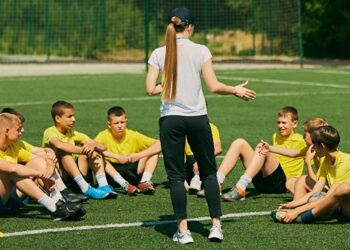In Part Three of The Power of Belonging in Community Recreation series, Marc Iturriaga explains how to welcome members beyond the front desk.
Community recreation centers pride themselves on being a welcoming place for all. We’ve focused on training staff to provide friendly and helpful customer service when people arrive at our doors, greeting everyone with a smile. Often, our intentional focus on welcoming ends at the front desk, but should also include program instructors, accessibility, music and imagery, space-making, staffing diversity, risk management and participant demographics.
The “welcome” is the way in which someone is met and spoken to when they arrive in your building. It is the culture, behaviors and understanding a member’s experience. How are they made to feel comfortable, important and accepted by staff, instructors, lifeguards, volunteers and fellow members? Are your programs, policies, facilities and structures created with a welcoming environment for all in mind?
We assume members coming to our facilities feel welcomed because we provided a space, posted memes on social media and offered programs we think they want. The fault lies in the current culture that puts the ownership on individuals to navigate the challenging landscape of community recreation. There is little to no intentional effort to create a sense of belonging outside of general customer service. We hope members will figure it out themselves. This approach works fine for those who understand most of the culture, rules and expectations that comes with the traditional fitness environment. They just need to know the specifics of your particular facility and programs. But what about those new to exercise and recreation, or who have been out of it for a while?
What can we do to ease the stress that comes when entering this new environment?
Provide training and development to staff that prioritizes fostering a welcoming environment. We value certifications, technical skills and experience from our instructors, yet most members will gravitate and give positive feedback because they like how the instructor made them feel, both physically and socially. Many of the fitness classes I have participated in often started with the instructor yelling into a microphone, a quick introduction and getting started with a warm-up.
For seasoned exercisers, this is normal, but what about someone new? How would they feel being injected into this environment for the first time? Do you give time before and after classes to orientate, answer questions or get to know your new members?
Virtual welcome. What can we do to help members feel comfortable even before they arrive? Show members, instructors and facilities in an authentic way, such as the different skill levels, the feel of programs, the variety of activities and the diversity of members. Create virtual tours that have personality so prospective members can feel like they have been to your facility before. Have real staff introduce themselves so members feel like they have met them before. Remember if your video doesn’t reflect the actual experience, new members won’t be fooled and most likely will not stick around.
Welcoming is more than a smile. What members see or don’t see in your facility is just as important in feeling welcome. Are your spaces accessible? Do the sounds and imagery they experience make them feel comfortable? Do they see themselves reflected in the staff, programs and participants? Are they able to navigate your facility easily?
Think of the impact gender-specific change rooms have on welcoming non-binary individuals. How many of your staff address a group of members in an activity as “guys?” Are members able to use discriminatory, racist or homophobic language without recourse? All of these have a significant impact on a member feeling welcome in your spaces and programs.
Facilitate the experience. Many community recreation programs and opportunities are facilitated by instructors, lifeguards, referees, personal trainers, etc., but what about activities that aren’t formally organized? Do you intentionally approach members in the fitness center or pool who appear to be mystified to help answer questions and make them feel comfortable? During sport play, do you have someone who educates members on the format, expectations and rules of play or do you put that responsibility on them? Organic play can be very beneficial to community building, but can also lead to exclusion where some players may not feel welcome in the space. Is there a way to do both? Alleviating stress and unknowns for your community is paramount in helping them feel welcome.
It is everyone’s role, not just the front desk staff, to make members feel welcome in your facility. When we see the experience through a new members’ eyes, we begin to understand the complexity and challenges they face as they brave a new environment. Let us be more intentional about how we welcome them so they feel like they belong.
Next time on The Power of Belonging in Community Recreation – Inclusion: The Space to Be Yourself.










